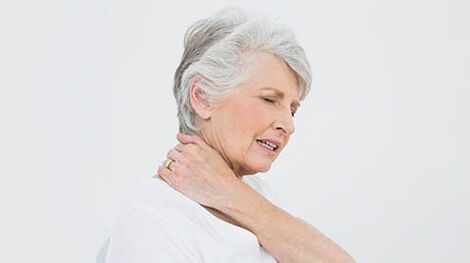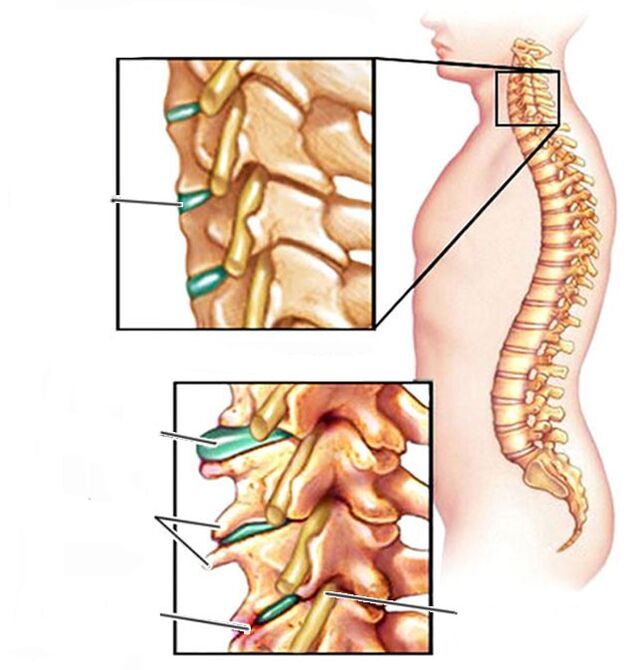The diagnosis of cervical osteonecrosis is based on simple studies - x-rays. In order for the disease to go into remission, an integrated approach is needed to treat osteonecrosis of the cervix.
In order for the disease to go into remission, an integrated approach is needed to treat osteonecrosis of the cervix.
Why does cervical bone necrosis appear?

The pain has several localized locations: neck, head, shoulder. Weakened neck muscles stimulate the development of bone necrosis. Due to incorrect posture, lack of movement and application of unnatural postures, some neck muscles are frequently tense, others spend too much time resting. The spine adjusts to unreasonable loads at the cost of its health. During cervical osteoporosis, the following changes are recorded:
- violation of blood and lymphatic flow;
- lack of nutrition of the connective tissue of the disc;
- unstable positions of the vertebral bodies relative to each other.
Gradually, the structures of the vertebra and the disc are destroyed. This process is irreversible, so you need to take care of your health on time and treat the cervical degenerative symptom immediately without delay. Reasons also include:
- neck injury;
- excess weight;
- connective tissue dysplasia;
- poor nutrition, not drinking enough water.
Cervical spine tumors: symptoms
Main signs (vertebrae):
- Pain. It may be pulled constantly or appear some time after the neck is resting, sleeping in an uncomfortable position. There are throbbing pain that makes the patient immobilize for a short time (low back pain);
- Ankle scoliosis or difficulty movement. Sometimes it hurts so much when turning or tilting the head that a person finds a comfortable position where the pain is the least, and tries to stay in that position;
- Muscle tension, feeling stiff, heavier;
- Crunchy spine when turning head. Extrinsic symptoms of cervical necrosis (with involvement of nerves and surrounding tissues);
- Inflammation of the muscles;
- Headache, migraine, dizziness, sometimes accompanied by nausea and vomiting;
- Post-headache pain, increased intracranial pressure, a feeling of heaviness; Such symptoms sometimes occur so clearly that the term "osteonecrosis" originated in patients. Clearly, headache is only a secondary manifestation of pathological changes in the skeletal system, rightly speaking degenerative diseases of the cervical vertebra, not the head;
- Sensory organs disorders: impaired hearing and vision, speech, tinnitus due to lack of brain nutrition;
- Pain in the collarbone, arms down to the palm of the hand;
- Tingling and chills in the neck and arms, sometimes numb to the fingers;
- Limit the range of motion of the arms (possibly on one side).
Dangerous consequences of cervical osteonecrosis: treatment is required!
If degenerative changes are not stopped, the following can be added to osteonecrosis:
- lenticular pain caused by a pinched nerve emanating from the spine;
- bulging and herniation, compressing the spinal cord and leading to complete paralysis;
- cervical pain (cervical migraine, dystrophic stage of the vertebral artery syndrome);
- the formation of osteoblasts on the vertebrae.
Treatments for degenerative cervical vertebrae
It is impossible to cure this disease with medicine. You can only get rid of pain syndrome with pain relievers. But they always have side effects, so should only be used in extreme cases. Symptoms and treatment of cervical necrosis of the spine varies from patient to patient and needs a unique approach.
Doctors have an extensive inventory of advanced technology at their disposal; they can choose the most efficient and effective technology. Effective in the treatment of cervical bone necrosis and its manifestations:
- traction on the DRX robot - it restores the correct position of the vertebrae without risk of injury;
- shock wave therapy - improves blood and lymph flow to the affected area, restores metabolic processes, relaxes muscles;
- interstitial electrical stimulation - against complications of bone necrosis, pain relief from pinched neuritis;
- HILT - laser therapy for instant pain relief.
The next stage in treating symptoms of degenerative cervical disease is restoring blood supply, consolidating the correct positions of the vertebrae. Rehabilitation can take several sessions and includes physical therapy, manual therapy, and the use of modern equipment. The more accurately the patient adheres to the specialist's recommendations, the higher the effectiveness of the technique. The final stage lies within the patient responsibility area:
- lifestyle and nutrition adjustments;
- exercise therapy regularly;
- active and optimistic living position.

























